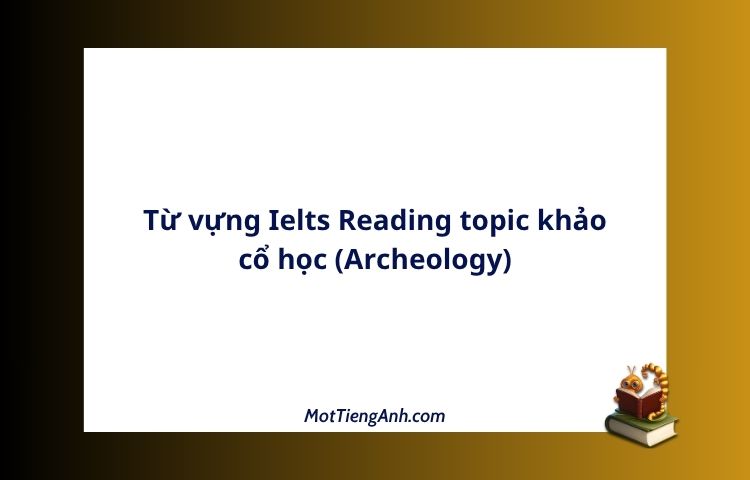Chinh phục IELTS Reading topic Khảo cổ học (Archeology) với bộ từ vựng đầy đủ nhất. Nắm vững các thuật ngữ chuyên ngành để bứt phá band điểm cùng Mọt Tiếng Anh.

Từ vựng IELTS Reading topic Archaeology – Tổng hợp chi tiết & ví dụ thực tế
Archaeology (Khảo cổ học) là chủ đề thường gặp trong IELTS Reading, đặc biệt ở các dạng bài như Matching Headings, Summary Completion và T/F/NG. Các bài đọc thường nói về di tích cổ, các nền văn minh mất tích, hoặc cách nhà khảo cổ phân tích hiện vật.
1. Từ vựng cơ bản trong lĩnh vực khảo cổ học
|
Từ vựng |
Phiên âm |
Nghĩa |
Ví dụ |
|
Archaeology |
/ˌɑː.kiˈɒl.ə.dʒi/ |
Khảo cổ học |
Archaeology helps us understand ancient civilizations. |
|
Archaeologist |
/ˌɑː.kiˈɒl.ə.dʒɪst/ |
Nhà khảo cổ |
The archaeologist uncovered a hidden tomb. |
|
Excavation |
/ˌek.skəˈveɪ.ʃən/ |
Cuộc khai quật |
The excavation revealed a Roman villa. |
|
Artifact |
/ˈɑː.tɪ.fækt/ |
Hiện vật |
The museum exhibited artifacts from the Stone Age. |
|
Fossil |
/ˈfɒs.əl/ |
Hóa thạch |
Fossils provide insight into prehistoric life. |
|
Site |
/saɪt/ |
Khu khảo cổ |
The site was once a thriving ancient city. |
|
Remains |
/rɪˈmeɪnz/ |
Di tích, phần còn lại |
Human remains were found near the temple ruins. |
|
Relic |
/ˈrel.ɪk/ |
Di vật |
The gold coin is a relic of the Byzantine Empire. |
|
Settlement |
/ˈset.əl.mənt/ |
Khu định cư |
Archaeologists found evidence of early settlements. |
|
Tomb |
/tuːm/ |
Mộ cổ |
The tomb contained treasures and royal remains. |
2. Từ vựng chuyên sâu & học thuật
|
Từ vựng |
Nghĩa |
Ví dụ |
|
Radiocarbon dating |
Phương pháp định tuổi bằng carbon |
Radiocarbon dating was used to estimate the age of the bones. |
|
Stratigraphy |
Phân tầng địa chất |
Stratigraphy helps determine the sequence of historical layers. |
|
Preservation |
Sự bảo tồn |
Preservation of ancient texts is crucial for historians. |
|
Deterioration |
Sự xuống cấp |
The artifacts suffered deterioration due to moisture. |
|
Ancient ruins |
Di tích cổ |
Ancient ruins tell the story of forgotten civilizations. |
|
Organic material |
Vật chất hữu cơ |
Organic materials decay faster without preservation. |
|
Inscriptions |
Chữ khắc |
The stone tablet was covered in Latin inscriptions. |
|
Cultural heritage |
Di sản văn hóa |
UNESCO protects sites of cultural heritage worldwide. |
|
Burial site |
Khu chôn cất |
The burial site contained tools and jewelry. |
|
Excavation layer |
Tầng khai quật |
Each excavation layer revealed new information. |
3. Collocations và cụm từ phổ biến
|
Cụm từ |
Nghĩa |
Ví dụ |
|
Unearth a discovery |
Khai quật một phát hiện |
They unearthed a major discovery in the Sahara. |
|
Conduct an excavation |
Tiến hành khai quật |
Experts conducted an excavation near the river. |
|
Remains intact |
Còn nguyên vẹn |
The ancient pottery remains intact despite centuries underground. |
|
Trace back to |
Có nguồn gốc từ |
The structure traces back to the Neolithic period. |
|
Decipher the script |
Giải mã ký tự |
They tried to decipher the script on the wall. |
|
Abandoned settlement |
Khu định cư bị bỏ hoang |
The abandoned settlement showed signs of famine. |
|
Dating techniques |
Kỹ thuật định tuổi |
New dating techniques improve accuracy in archaeology. |
|
Provide clues about |
Cung cấp manh mối về |
The tools provide clues about daily life. |
|
Historical significance |
Tầm quan trọng lịch sử |
The temple holds great historical significance. |
4. Từ vựng liên quan đến nền văn minh & thời kỳ lịch sử
|
Từ vựng |
Nghĩa |
Ví dụ |
|
Neolithic |
Thời kỳ đồ đá mới |
Neolithic tools were found buried in the cave. |
|
Paleolithic |
Thời kỳ đồ đá cũ |
Paleolithic art includes cave paintings. |
|
Bronze Age |
Thời kỳ đồ đồng |
The Bronze Age marked advancements in metallurgy. |
|
Iron Age |
Thời kỳ đồ sắt |
Weapons from the Iron Age were discovered near the site. |
|
Ancient civilization |
Nền văn minh cổ đại |
Ancient civilizations left behind remarkable structures. |
|
Prehistoric era |
Thời tiền sử |
Prehistoric remains are often poorly preserved. |
|
Mesopotamia |
Lưỡng Hà cổ đại |
Mesopotamia is considered the cradle of civilization. |
|
Hieroglyphics |
Chữ tượng hình Ai Cập |
Hieroglyphics were carved into the temple walls. |
5. Idioms & cách diễn đạt học thuật
|
Diễn đạt |
Nghĩa |
Ví dụ |
|
Stand the test of time |
Tồn tại qua nhiều thế kỷ |
These ruins have stood the test of time. |
|
A window into the past |
Cánh cửa nhìn về quá khứ |
The cave paintings provide a window into the past. |
|
Lost in history |
Bị lịch sử lãng quên |
Some civilizations were lost in history. |
|
Pieces of the puzzle |
Mảnh ghép trong bức tranh |
Each artifact is a piece of the puzzle of history. |
6. Gợi ý nguồn luyện tập từ vựng & kỹ năng đọc
|
Nguồn học |
Mô tả |
|
Cambridge IELTS (9–18) |
Có nhiều bài đọc về khảo cổ học, phù hợp luyện dạng T/F/NG |
|
National Geographic / BBC History |
Bài viết có nhiều từ học thuật về khảo cổ, dễ luyện paraphrase |
|
Từ điển Oxford + Collins Academic |
Tra nghĩa chính xác và ví dụ ngữ cảnh |
|
TED-Ed – Archaeology playlist |
Video ngắn về kỹ thuật khai quật, dễ hiểu và sinh động |
7. Kết luận
Việc học và ghi nhớ từ vựng IELTS Reading chủ đề Archaeology không chỉ giúp bạn cải thiện tốc độ đọc mà còn tăng khả năng nhận diện paraphrase, ý chính của đoạn văn, và dễ dàng xử lý các dạng bài có tính học thuật cao.
Gợi ý học:
- Tạo flashcards với ví dụ thực tế.
- Đọc các bài trong Cambridge IELTS và ghi chú từ vựng.
- Làm bài tập dạng summary/matching headings chủ đề khảo cổ để luyện tập.
Hy vọng bộ từ vựng IELTS Reading chủ đề Khảo cổ học trên đây sẽ giúp bạn tự tin hơn khi làm bài. Mọt Tiếng Anh chúc bạn ôn luyện hiệu quả và đạt được band điểm IELTS như mong đợi!


